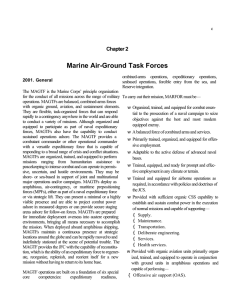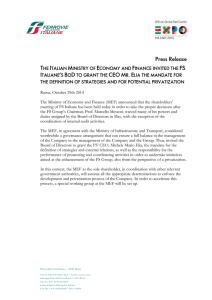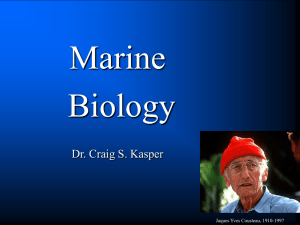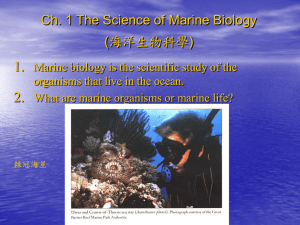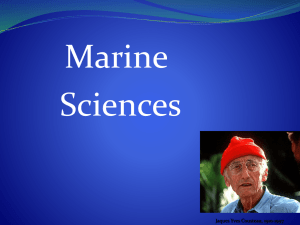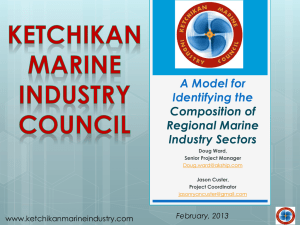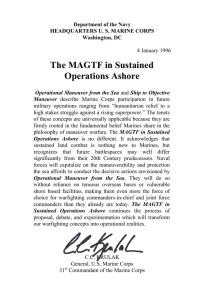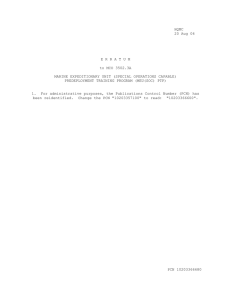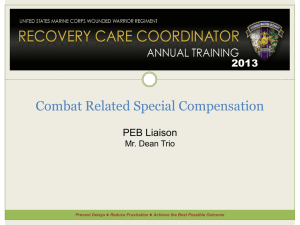USMC Intro - SUNY Maritime College
advertisement
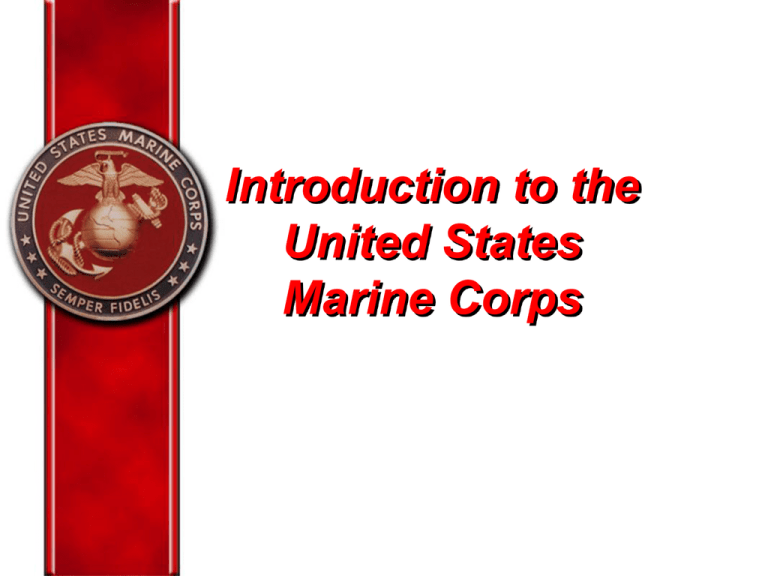
Introduction to the United States Marine Corps Our Culture Core Values • Honor • Courage • Commitment Our most important attributes. This is what we stand for. Mission • Make Marines • Win Battles • Create Quality Citizens Mission accomplishment is the foundation of our reputation This is what we do. Priority #1 • Our Marines and Sailors in combat Our top priority is a reflection of our warrior ethos: “…the stuff of which heroes are made.” This is who we are. Elite Warriors • The Corps and individual Marine strive to be the epitome of military virtue • Smart, tough, warriors who gain strength of mind, body, and character through earning a place in an elite and proud organization This is what we aspire to be. Every Marine a Rifleman • All Marines are basic riflemen first, regardless of specialty • 25% of enlisted recruit training is dedicated to rifle marksmanship • TBS trains officers to be infantry platoon commanders • Our history is full of examples of pilots, logisticians, & administrators assigned infantry duties Naval Character • The Marine Corps is fundamentally a naval service – “Soldiers of the Sea” • Sea provides avenue for projecting power practically anywhere • Today the Navy-Marine Corps team has the unique ability to provide forward-deployed expeditionary combat forces in response to crises Expeditionary Mindset • “Word came on May 27 that another revolution was in full swing at Bluefields, on the east coast of Nicaragua. We received orders to leave at eight thirty in the morning and by eleven thirty were on our way—two hundred and fifty officers and men. Mrs. Butler had [gone] . . . to do some shopping. When she returned at noon, I was gone . . .” — Smedley D. Butler • Being expeditionary is a state of mind – “Bags packed”… ready to deploy on a moment’s notice – Spartan attitude: willingness to endure hardship and austere conditions Innovative • • • • • Close Air Support Amphibious Operations Naval Gunfire Support Vertical envelopment Maritime Prepositioning Korea, September 1951 “The Marines’ combatant function was and is unique. Nobody has ever been interested in providing the necessary operating techniques of hardware for them, so they have had to do it themselves.” - LtGen Victor H. Krulak, First to Fight Warfighting Philosophy Doctrine • MCDP-1 Warfighting – Cornerstone doctrinal publication – The nature and theory of warfare, how to prepare for it, and how to conduct it – Read by all ranks Warfighting Philosophy • Maneuver Warfare – “… a warfighting philosophy that seeks to shatter the enemy’s cohesion through a variety of rapid, focused, and unexpected actions which create a turbulent and rapidly deteriorating situation with which the enemy cannot cope.” (MCDP-1) • Aims to shatter enemy system rather than completely destroy his forces • Maneuver in space (positional) and time (temporal) Warfighting Philosophy • Key Ingredients of Maneuver Warfare – Speed • Establish pace the enemy can’t maintain – Focus • Against enemy’s critical vulnerabilities – Ruthless Opportunism • Seek out weakness – Surprise • Strike at unexpected time and place Warfighting Philosophy • Maneuver Warfare requires leaders with a flexibility and independence of mind – Initiative and judgment crucial at all levels • USMC is the youngest military service – About 2/3 are 25 or younger • Officer to Enlisted Ratios – – – – Air Force Army Navy Marines 1:4 1:5 1:6 1:8.5 Warfighting Philosophy • Philosophy of Command – Must be decentralized – Not just equipment and procedures – Human element of command is critical • Boldness, initiative, personality, strength of will, imagination – Lead from the front • Where you can best influence the action • Show willingness to share danger and privation Warfighting Philosophy • Mission Tactics – Subordinates tasked to accomplish a mission without specifying “how” – Small unit leaders expected to adapt to changing situations rather than wait for seniors’ permission – Freedom for initiative permits high tempo ops Warfighting Philosophy • Combined Arms – The full integration of arms in such a way that to counteract one, the enemy must become more vulnerable to another – Takes advantage of complimentary characteristics of different types of units – Pose the enemy not just with a problem, but with a dilemma — a no-win situation Organization Marine Air Ground Task Force • MAGTF is a balanced, airground combined arms task organization of Marine Corps forces under a single commander, structured to accomplish a specific mission. What does that mean? a. Ground Marines, aircraft, and support b. Put them all under a single Headquarters Element c. They fight together for one common mission. MAGTF Basic Organization Command Element (CE) Ground Combat Element (GCE) Air Combat Element (ACE) Logistics Combat Element (LCE) Basic structure never varies, but number, type, and size of units in each of the four elements will be mission-dependent. Command Element (CE) • Headquarters integrates the ACE, GCE, and LCE together to accomplish a mission • Command and Control (C2) functions Ground Combat Element (GCE) • Ground combat power • May include: – – – – – – – Infantry Artillery Tanks Amphibious Assault Vehicles (AAV) Light Armored Recon (LAR) Combat Engineers Reconnaissance Air Combat Element (ACE) • Air and lift capabilities • May include: – Fixed & rotary wing • Attack • Assault – Marine air control • Air Traffic Control (ATC) • Air defense – Aviation logistics and support Logistics Combat Element (LCE) • Logistical sustainment • Functions include: – – – – – – Transportation Supply (food, fuel, ammo) Maintenance General engineering Health services (medical/dental) General Services MAGTF Strengths • Leverages strengths of different units + weapon systems to achieve combined arms effect – MAGTF commander has a “joint” type force • Scalable – Task-organized based on mission • Flexible – Wide range of capabilities and weapon systems • In a JTF, Marine aviation assets remain under control of MAGTF commander vice JFACC Some MAGTF Capabilities • Forcible entry (Amphibious Assault) • Deterrence • Demonstrations • Amphibious Raids • Limited Objective attacks • 3-Block Warfare • Seizure of terrain, bases, territory • Disaster Relief • Non-Combatant Evacuation Op (NEO) • Stability/Peace keeping • TRAP • Humanitarian • Visit, Board, Search & Seizure (VBSS) • Mass Casualty Four Types of MAGTFs • • • • Marine Expeditionary Force (MEF) – large Marine Expeditionary Brigade (MEB) – medium Marine Expeditionary Unit (MEU) – small Special Purpose MAGTF (SPMAGTF) – varies CE GCE ACE LCE Marine Expeditionary Force (MEF) • • • • The largest and principal MAGTF 35,000-55,000 Marines + Sailors 60 days sustainment Only standing MAGTF Commanded by: Lt General MEF HQ Group (CE) Marine Division (GCE) Marine Air Wing (ACE) Marine Logistics Group (LCE) MEF Headquarters II MEF I MEF Camp Pendleton, CA Camp Lejeune, NC III MEF Okinawa, Japan Marine Expeditionary Brigade (MEB) • 5,000-15,000 Marines + Sailors • 30 days sustainment Commanded by: Brig. General MEB HQ (CE) Infantry Regiment (rein) (GCE) Aircraft Group (ACE) Combat Logistics Regiment (LCE) Marine Expeditionary Unit (MEU) • 2,200 Marines + Sailors • 15 days sustainment • Forward deployed on amphibious ships Commanded by: Colonel – 6 hour response – Can reach 75% of world’s littorals in about 5 days MEU HQ (CE) Infantry Battalion (rein) (GCE) Composite Aviation Squadron (ACE) Combat Logistics Battalion (LCE) MEU – Typical Operating Areas II MEF I MEF III MEF • 22nd MEU • 11th MEU • 31st MEU • 24th MEU • 13th MEU • 26th MEU • 15th MEU Special Purpose MAGTF • Anything and everything • Tailored to meet specific missions • Occasionally assembled because no other MAGTF structures are available Recent Examples • MEF – OIF: I MEF (rein with 2nd MarDiv) deployed to Kuwait and attacked 500 miles into Iraq, 2003 • MEB – Desert Storm: 4th + 5th MEBs conducted an amphib demonstration (deception) off Kuwaiti coast, 1991 • MEU – East Timor: 11th MEU (SOC) – humanitarian assistance, 1999 – Liberia: 26th MEU (SOC) landed Marines to support peacekeeping efforts in Monrovia, 2003 • SPMAGTF – New Orleans: Humanitarian assistance ops post Katrina, 2005 USMC: What we are… • • • • • • • A forward deployed force A Truly expeditionary force in readiness An instrument of real presence A young force A lean force An inexpensive force An institutionally paranoid force “If we didn’t have a Marine Corps, we would have to invent one.” …and what we are not • An Army – Immense combat power – Logistics for the sustained fight • An Air Force – – – – Strategic Lift Air-to-Air Refueling Numbers & Endurance Strategic Piece • A Special Operations Force – Training – Equipment Bottom Line • The Marine Corps can: – Kick down the front door – Go in the back door (stealth and surprise) – Knock the house down (destroy) – Fix the house (humanitarian-disaster relief) • The Navy-Marine Corps Team can: – Loiter for long periods (threat, diplomatic pressure) – Self sustain Bottom Line • The Marine Corps cannot: –Replace the Army –Replace the Air Force –Replace Special Operations Forces Take Aways • Unique culture • Warfighting philosophy based on maneuver and combined arms • Expeditionary force-in-readiness • Task organized as MAGTFs = Combined arms, air-ground team Questions?

